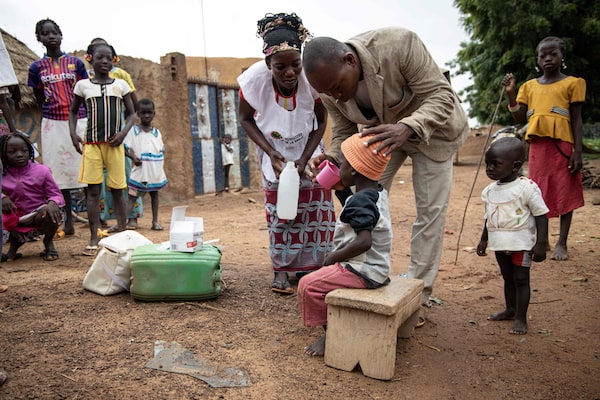
In the 29 countries where malaria is most present, the situation is getting worse.OLYMPIA DE MAISMONT/AFP/Getty Images
Eradicating malaria, one of the world’s oldest and deadliest diseases, within a generation is ambitious, but both achievable and necessary, according to a blue-ribbon panel of global health experts.
“For too long, malaria eradication has been a distant dream, but now we have evidence that malaria can and should be eradicated by 2050,” said Sir Richard Feachem, director of the global health group at the University of California, San Francisco. He is also co-chair of the Lancet Commission on Malaria Eradication, a group of experts in public health, infectious disease, epidemiology and economics, whose findings are published in Monday’s edition of the medical journal The Lancet.
Malaria, a parasitic disease transmitted through the bite of infected female Anopheles mosquitoes, has caused incalculable illness and death over thousands of years. Even today, there are an estimated 220 million cases and 435,000 deaths annually.
The good news is, since the year 2000, the incidence of malaria has fallen by 36 per cent, and the death rate by 60 per cent.
The bad news is that in the 29 countries where malaria is most present, the situation is getting worse.
Members of the Lancet Commission concluded that while progress is being made, it’s not happening quickly enough, and progress has stalled in recent years. “We simply cannot continue with a business as usual approach,” Dr. Feachem said.
In fact, the experts are calling for a fundamental philosophical shift: Instead of gradually reducing malaria in most countries, they are calling on governments and global health organizations to commit to eradication “with purpose, dedication and urgency.”
The urgency is necessary not just for humanitarian reasons, but biological ones. Both the parasites that cause malaria and the mosquitoes that carry them have been mutating, making it more difficult to both prevent transmission and treat the infected.
The scientific and technical expertise to undertake eradication exists, at least in theory.
Yet, only one disease that affects humans has been eradicated, smallpox. Another, polio, is close.
Malaria is, in many ways, a bigger challenge because there is no effective vaccine, the parasite has non-human hosts, and there are several strains of the deadly parasite and they are mutating.
A century ago, malaria was endemic in every country on earth. By the mid-20th century, it was still commonplace in 143 countries. In 1954, a malaria eradication plan was launched. It was abandoned in 1978, at which time there were 106 endemic countries.
The earlier eradication plan was fundamentally flawed because it excluded tropical Africa, where malaria is most prevalent.
The difference today is that we “know what we need to do,” Tedros Adhanom Ghebreyesus, director-general of the World Health Organization, wrote in The Lancet.
The commission said what is required is a three-pronged strategy to “bend the curve” until zero transmission of the disease is achieved:
1) Improve current malaria-control programs, many of which are poorly managed and inadequately staffed, which would require commitment especially from governments in the hardest-hit countries;
2) Find new tools to overcome biological challenges, meaning develop new drugs and ways to eliminate infectious mosquitoes.
3) Increase funding: About US$4.3-billion a year is spent annually on malaria control and prevention. The commission said that needs to increase to US$6-billion.
The principal prevention methods are insecticide-treated bed nets and prophylactic medicines (meaning they prevent transmission).
In infected patients, the parasite multiplies in the liver and destroys red blood cells. This can cause symptoms such as fever, chills and seizures and, in severe cases, brain damage or death. People can also be reinfected. Almost two-thirds of those who die of malaria are children under the age of five.
Treatment of patients infected with malaria aims to destroy the parasites circulating in the blood, which is done principally with artemisinin-based combination therapies.
Dr. Tedros said one of the principal reasons so many people die of malaria is they don’t have access to basic health care, but one of the lasting legacies of eradication efforts could be bolstering primary care.
There is no question that eradication is a goal of epic proportions. But it’s also one that could produce a tremendous return on investment.
What remains to be seen is if, given all the other infectious-disease killers, ridding the world of malaria is a challenge that global leaders will embrace.
Our Morning Update and Evening Update newsletters are written by Globe editors, giving you a concise summary of the day’s most important headlines. Sign up today.
 André Picard
André Picard